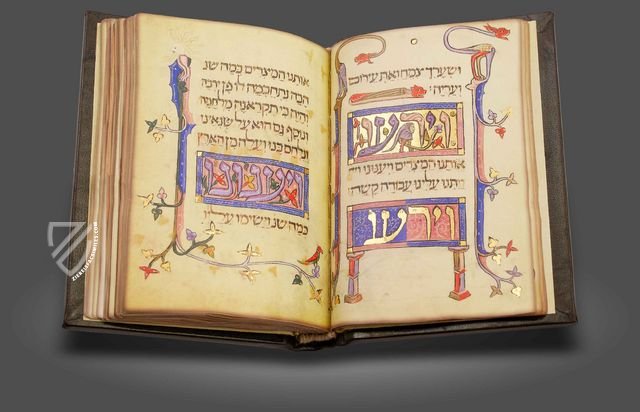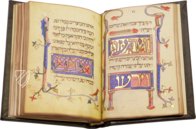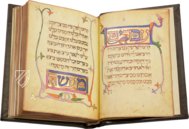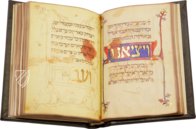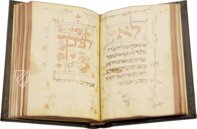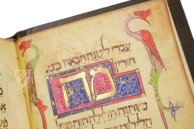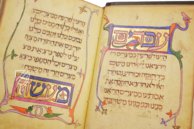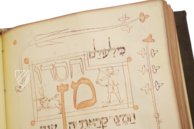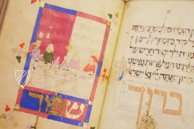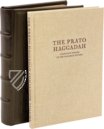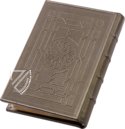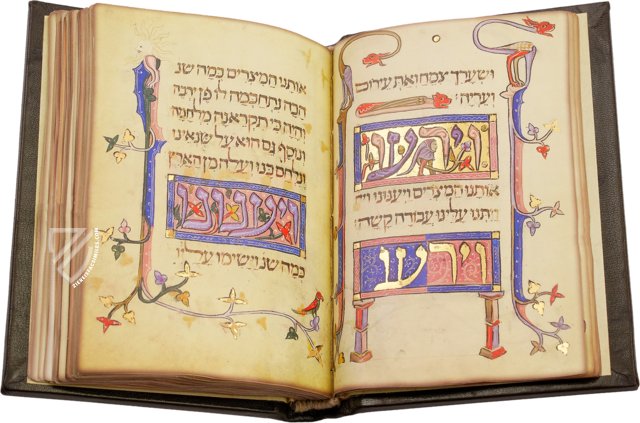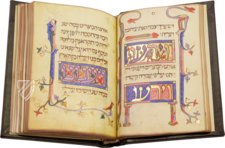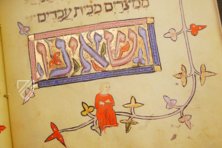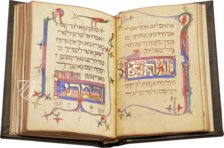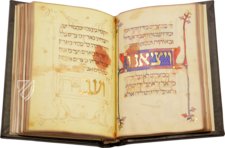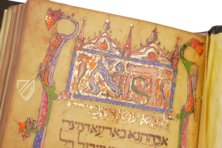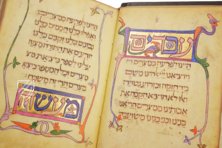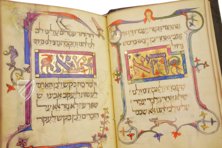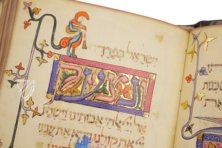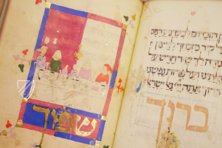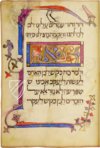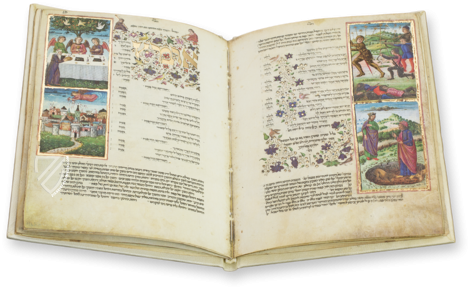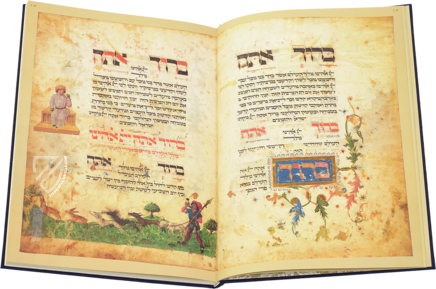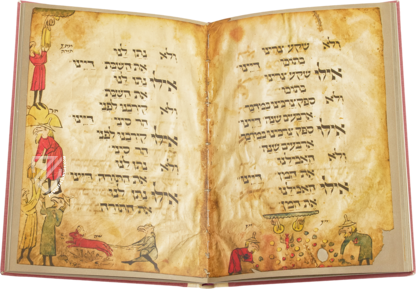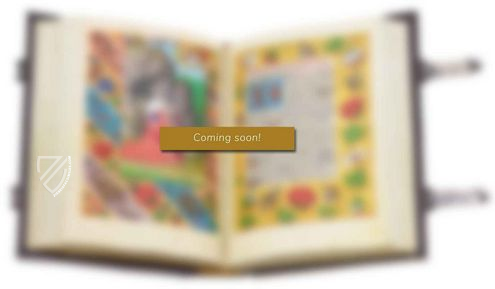Prato Haggadah
(3,000€ - 7,000€)
Jewish culture is communicated in a fantastic manner through this manuscript from Spain, which was completed ca. 1300. Unbelievably rich and extraordinarily refined in its artistic decoration, the so-called Prato Haggadah brings the celebratory texts and songs of Passover meal on the occasion of the freeing of the Israelites from Egyptian imprisonment to full expression. Through the rare event that several of the miniatures are left uncompleted, it is possible to comprehend the creation process of a magnificently decorated manuscript. Furthermore, the Prato Haggadah is one of the oldest Spanish Haggadot in history.
Prato Haggadah
Jewish culture is communicated in a fantastic manner through this manuscript from Spain, which was completed ca. 1300. Unbelievably rich and extraordinarily refined in its artistic decoration, the so-called Prato Haggadah brings the celebratory texts and songs of Passover meal on the occasion of the freeing of the Israelites from Egyptian imprisonment to full expression. Through the rare event that several of the miniatures are left uncompleted, it is possible to comprehend the creation process of a magnificently decorated manuscript. Furthermore, the Prato Haggadah is one of the oldest Spanish Haggadot in history.
Huge Importance for Passover
The Passover festival on the occasion of the flight of the Israelites from Egypt stands as a central pillar within Jewish culture. Therefore on the eve of the event, a special feast is held. Accompanying this great meal are stories from the Book of Exodus and songs, which are read aloud from the Haggadah, as well as sung. Especially valuable texts like the Prato-Haggadah were rarely on hand. It can be speculated, whether or not this text was given by an important patron, or whether the book with the religious text had another context.
A Magnificent Manuscript for a Synagogue?
Unlike most Haggadot, the Prato Haggadah contains no text that is immediately connected with the actual meal, food, and rights at the table. This fact has led to the assumption that the Spanish manuscript was used for public readings in a Synagogue, and the faithful would head home for their own personal Haggadah in their residence. The splendid layout of the manuscript would also underline this assumption. Originating ca. 1300 in Spain – counting as one of the oldest Spanish Haggadot – the Prato Haggadah impresses next to the Hebrew text, especially through its richly pictorial furnishings.
Extraordinary Artistic Design
100 miniatures are collected throughout the 160 pages. They are enriched with bright colors and precious gold and silver. One can even find entire page depictions – like a Passover meal – as bright borders for the lines of text in the form of ornamental jewelry, which are provided figurative elements. Mythical creatures, birds, dogs, and other animals romp between the stylized leaflets. The artist clearly let his fantasies run free here, as he integrated humorous and soulful scenes. Thus, many pages are witness to a large rabbit hunt. Even the initials are artfully decorated and rounded by a partly colorful frame.
An Anomaly of Manuscripts
Despite the splendid design of the manuscript, the work is nonetheless an unfinished illuminated Hebrew manuscript. This makes it an extraordinarily rare specimen and allows the beholder an interesting glimpse into the creation process of a manuscript. Thus the production steps required to craft a fine script can come to be fully understood, which only serves to bring the beholder and the original artists together. The Prato Haggadah is therefore, considered in its totality, an invaluable work both for the history of art, and also for the analysis of the most important festival on the Jewish calendar, Passover.
Codicology
- Alternative Titles
- Haggadah de Prato
Prato-Haggadah
Prato-Haggada - Size / Format
- 160 pages / 21.0 × 14.0 cm
- Origin
- Spain
- Date
- Ca. 1300
- Epochs
- Style
- Language
- Illustrations
- 40 miniatures illuminated in gold and silver and 60 partially illuminated or only drawn
Prato Haggadah
Hunting Dog in Pursuit
This manuscript is exemplary of the animals and drolleries that were popular décor in Hebrew manuscripts. On the right, a horned drollery is seated on the tip of the marginalia while a blackbird has perched itself on a leaf to the left. A pink greyhound is seen running, but upon closer look it is pursuing something – a rabbit that was not colored in before the manuscript was completed. Below and to the left, the tracing of an uncolored songbird can also be found.
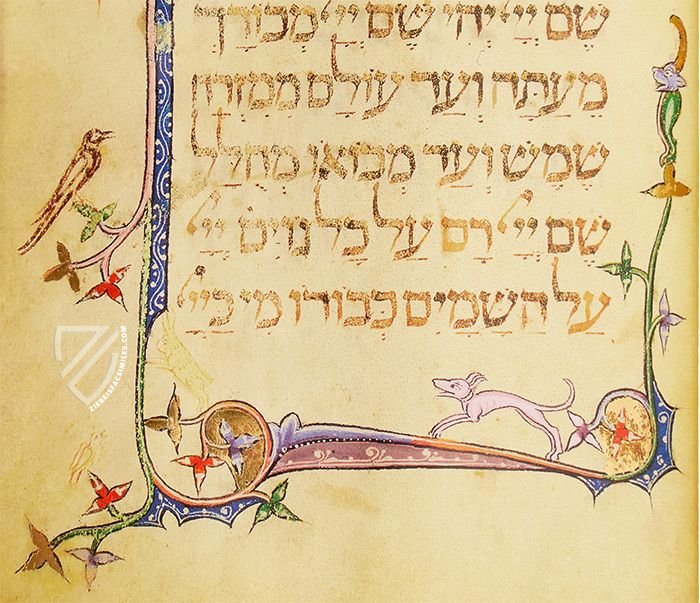
Prato Haggadah
Incipit Page: Fol. 10
This incipit page is a wonderful blend of Hebrew illumination and the Spanish Gothic style from ca. 1300. It has an unusual palette that takes the typical primary colors and lightens them: the blue is brighter and contrasted with reds that are either more purple or orange in tone. Thick gold leaf ennobles the artistry of this perfectly executed but incomplete page.
One can clearly see a monkey holding a fruit, a two-legged hybrid, a crane, and in the upper margin another crane, but this one has the head of a huntsman. Upon closer inspection, a rabbit and a songbird can be found in the lower margin. Only their traces can be seen, and like most miniatures in this manuscript, they were not colored before work on it suddenly and mysteriously ended.
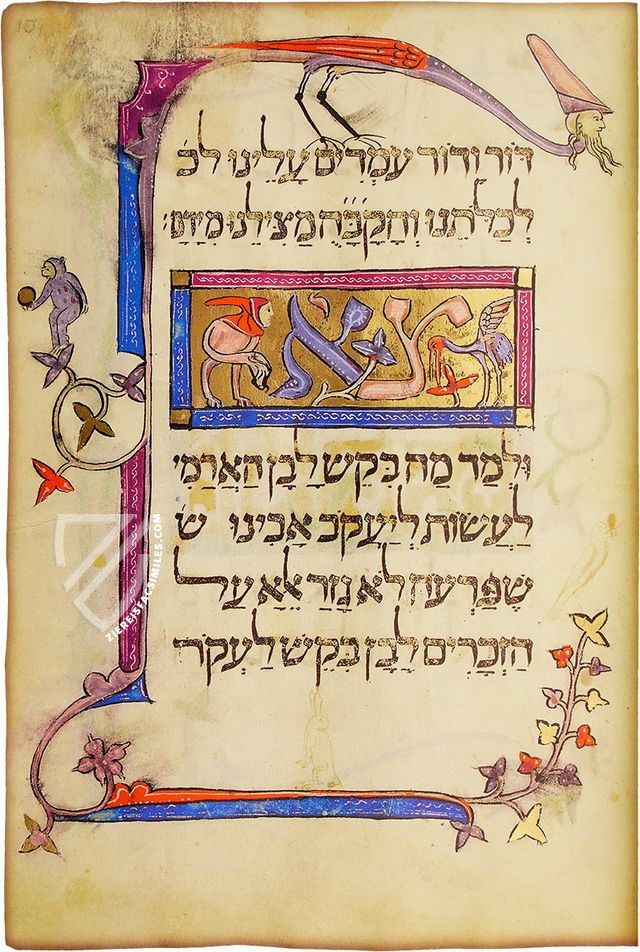
#1 Prato Haggadah
(3,000€ - 7,000€)
- Treatises / Secular Books
- Apocalypses / Beatus
- Astronomy / Astrology
- Bestiaries
- Bibles / Gospels
- Chronicles / History / Law
- Geography / Maps
- Saints' Lives
- Islam / Oriental
- Judaism / Hebrew
- Single Leaf Collections
- Leonardo da Vinci
- Literature / Poetry
- Liturgical Manuscripts
- Medicine / Botany / Alchemy
- Music
- Mythology / Prophecies
- Psalters
- Other Religious Books
- Games / Hunting
- Private Devotion Books
- Other Genres
- Afghanistan
- Armenia
- Austria
- Belgium
- Colombia
- Croatia
- Cyprus
- Czech Republic
- Denmark
- Egypt
- Ethiopia
- France
- Germany
- Greece
- Hungary
- India
- Iran
- Iraq
- Israel
- Italy
- Japan
- Lebanon
- Luxembourg
- Mexico
- Morocco
- Netherlands
- Palestine
- Peru
- Poland
- Portugal
- Russia
- Serbia
- Spain
- Sri Lanka
- Sweden
- Switzerland
- Syria
- Turkey
- Ukraine
- United Kingdom
- United States
- Uzbekistan
- Aboca Museum
- Ajuntament de Valencia
- Akademie Verlag
- Akademische Druck- u. Verlagsanstalt (ADEVA)
- Aldo Ausilio Editore - Bottega d’Erasmo
- Alecto Historical Editions
- Alkuin Verlag
- Almqvist & Wiksell
- Amilcare Pizzi
- Andreas & Andreas Verlagsbuchhandlung
- Archa 90
- Archiv Verlag
- Archivi Edizioni
- Arnold Verlag
- ARS
- Ars Magna
- ArtCodex
- AyN Ediciones
- Azimuth Editions
- Badenia Verlag
- Bärenreiter-Verlag
- Belser Verlag
- Belser Verlag / WK Wertkontor
- Benziger Verlag
- Bernardinum Wydawnictwo
- BiblioGemma
- Biblioteca Apostolica Vaticana (Vaticanstadt, Vaticanstadt)
- Bibliotheca Palatina Faksimile Verlag
- Bibliotheca Rara
- Boydell & Brewer
- Bramante Edizioni
- Bredius Genootschap
- Brepols Publishers
- British Library
- C. Weckesser
- Caixa Catalunya
- Canesi
- CAPSA, Ars Scriptoria
- Caratzas Brothers, Publishers
- Carus Verlag
- Casamassima Libri
- Chavane Verlag
- Christian Brandstätter Verlag
- Circulo Cientifico
- Club Bibliófilo Versol
- Club du Livre
- CM Editores
- Collegium Graphicum
- Collezione Apocrifa Da Vinci
- Comissão Nacional para as Comemorações dos Descobrimentos Portugueses
- Coron Verlag
- Corvina
- CTHS
- D. S. Brewer
- Damon
- De Agostini/UTET
- De Nederlandsche Boekhandel
- De Schutter
- Deuschle & Stemmle
- Deutscher Verlag für Kunstwissenschaft
- DIAMM
- Droz
- E. Schreiber Graphische Kunstanstalten
- Ediciones Boreal
- Ediciones Grial
- Ediclube
- Edições Inapa
- Edilan
- Editalia
- Edition Deuschle
- Edition Georg Popp
- Edition Leipzig
- Edition Libri Illustri
- Editiones Reales Sitios S. L.
- Éditions de l'Oiseau Lyre
- Editions Medicina Rara
- Editorial Casariego
- Editorial Mintzoa
- Editrice Antenore
- Editrice Velar
- Edizioni Edison
- Egeria, S.L.
- Eikon Editores
- Electa
- Emery Walker Limited
- Enciclopèdia Catalana
- Eos-Verlag
- Ephesus Publishing
- Ernst Battenberg
- Eugrammia Press
- Extraordinary Editions
- Fackelverlag
- Facsimila Art & Edition
- Facsimile Editions Ltd.
- Facsimilia Art & Edition Ebert KG
- Faksimile Verlag
- Feuermann Verlag
- Folger Shakespeare Library
- Franco Cosimo Panini Editore
- Friedrich Wittig Verlag
- Fundación Hullera Vasco-Leonesa
- G. Braziller
- Gabriele Mazzotta Editore
- Gebr. Mann Verlag
- Gesellschaft für graphische Industrie
- Getty Research Institute
- Giovanni Domenico de Rossi
- Giunti Editore
- Graffiti
- Grafica European Center of Fine Arts
- Guido Pressler
- Guillermo Blazquez
- Gustav Kiepenheuer
- H. N. Abrams
- Harrassowitz
- Helikon
- Hendrickson Publishers
- Henning Oppermann
- Herder Verlag
- Hes & De Graaf Publishers
- Hoepli
- Holbein-Verlag
- Hortus Deliciarum
- Houghton Library
- Hugo Schmidt Verlag
- Idion Verlag
- Il Bulino, edizioni d'arte
- ILte
- Imago
- Insel Verlag
- Instituto Nacional de Antropología e Historia
- Istituto dell'Enciclopedia Italiana - Treccani
- Istituto Ellenico di Studi Bizantini e Postbizantini
- Istituto Geografico De Agostini
- Istituto Poligrafico e Zecca dello Stato
- Italarte Art Establishments
- J. Thorbecke
- Jan Thorbecke Verlag
- Johnson Reprint Corporation
- Josef Stocker
- Josef Stocker-Schmid
- Jugoslavija
- Karl W. Hiersemann
- Kasper Straube
- Kaydeda Ediciones
- Kindler Verlag / Coron Verlag
- Kodansha International Ltd.
- Konrad Kölbl Verlag
- Kurt Wolff Verlag
- La Liberia dello Stato
- La Linea Editrice
- La Meta Editore
- Lambert Schneider
- Landeskreditbank Baden-Württemberg
- Leo S. Olschki
- Les Incunables
- Library of Congress
- Libreria Musicale Italiana
- Lichtdruck
- Lito Immagine Editore
- Lumen Artis
- Lund Humphries
- M. Moleiro Editor
- Maison des Sciences de l'homme et de la société de Poitiers
- Manuscriptum
- Martinus Nijhoff
- Maruzen-Yushodo Co. Ltd.
- MASA
- McGraw-Hill
- Militos
- Millennium Liber
- Müller & Schindler
- Nahar and Steimatzky
- National Library of Wales
- Neri Pozza
- Nova Charta
- Oceanum Verlag
- Odeon
- Orbis Mediaevalis
- Orbis Pictus
- Österreichische Staatsdruckerei
- Oxford University Press
- Pageant Books
- Parzellers Buchverlag
- Patrimonio Ediciones
- Pattloch Verlag
- PIAF
- Pieper Verlag
- Plon-Nourrit et cie
- Prestel Verlag
- Princeton University Press
- Prisma Verlag
- Priuli & Verlucca, editori
- Pro Sport Verlag
- Propyläen Verlag
- Pytheas Books
- Quaternio Verlag Luzern
- Reales Sitios
- Recht-Verlag
- Reichert Verlag
- Reichsdruckerei
- Riehn & Reusch
- Roberto Vattori Editore
- Rosenkilde and Bagger
- Roxburghe Club
- Salerno Editrice
- Sarajevo Svjetlost
- Schöck ArtPrint Kft.
- Scolar Press
- Scrinium
- Scripta Maneant
- Scriptorium
- Siloé, arte y bibliofilia
- SISMEL - Edizioni del Galluzzo
- Sociedad Mexicana de Antropología
- Société des Bibliophiles & Iconophiles de Belgique
- Soncin Publishing
- Sorli Ediciones
- Stainer and Bell
- Studer
- Styria Verlag
- Sumptibus Pragopress
- Szegedi Tudomànyegyetem
- Taberna Libraria
- Tarshish Books
- Taschen
- Tempus Libri
- Testimonio Compañía Editorial
- Thames and Hudson
- The Clear Vue Publishing Partnership Limited
- The Facsimile Codex
- The Folio Society
- The Marquess of Normanby
- The Richard III and Yorkist History Trust
- Tip.Le.Co
- TouchArt
- TREC Publishing House
- TRI Publishing Co.
- Trident Editore
- Typis Regiae Officinae Polygraphicae
- Union Verlag Berlin
- Universidad de Granada
- University of California Press
- University of Chicago Press
- Urs Graf
- Vallecchi
- Van Wijnen
- VCH, Acta Humaniora
- VDI Verlag
- VEB Deutscher Verlag für Musik
- Verlag Anton Pustet / Andreas Verlag
- Verlag Bibliophile Drucke Josef Stocker
- Verlag der Münchner Drucke
- Verlag für Regionalgeschichte
- Verlag Styria
- Vicent Garcia Editores
- W. Turnowsky
- Waanders Printers
- Wiener Mechitharisten-Congregation (Wien, Österreich)
- Wissenschaftliche Buchgesellschaft
- Wydawnictwo Dolnoslaskie
- Xuntanza Editorial
- Zakład Narodowy
- Zollikofer AG

